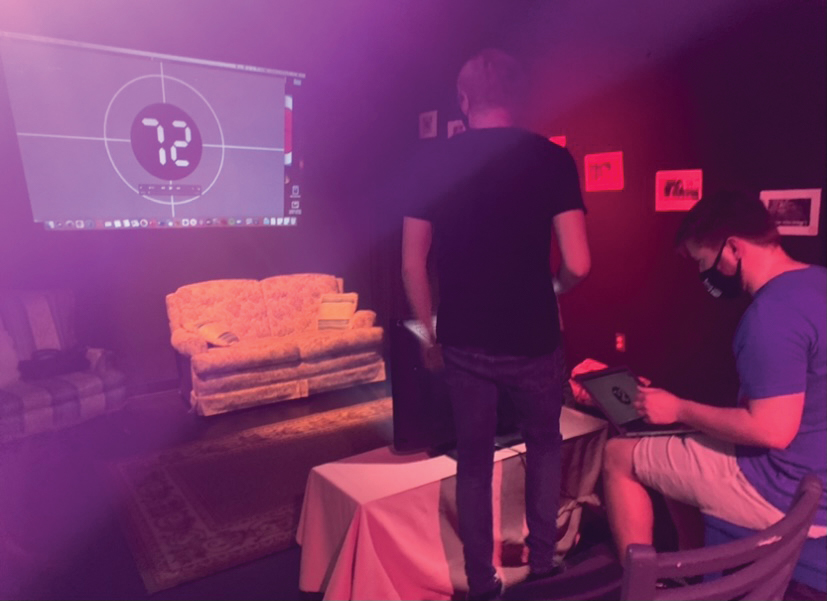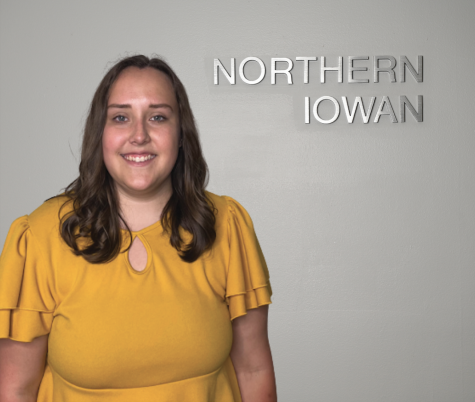Interpreters Theatre hosts social change display
UNI’s Interpreter Theatre displayed four installations presenting important social topics.
Apr 29, 2021
UNI Interpreters Theatre was set up in Lang Hall for the evening of April 27 to showcase four student-driven installations of interactive media, props of items and human actors, statistics and interactive performances. These installations presented four startling statistics that aim to present the issues as if participants were dealing with it first-hand.
Along with sexual assault, other installations presented topics of climate change, human trafficking and gun related suicide.
Interpreters Theatre Director and Communication and Media Professor Joshua Hamzehee recalls acknowledging all of the deaths related to COVID-19 since the beginning of the pandemic and recognizing other recent social changes that have become topics of conversation.
He also realized the importance of a live performance as well as utilizing the performance space available to the Interpreters Theatre. The brainstorming was opened up to his students, where they were able to choose topics and statistics they felt they needed to share.
“I wanted us to help put a face and context to these numbers that seem overwhelming while also allowing the audience to come up with their own interpretations,” he said.
The sexual assault installation involved the interpretation of a sitcom setting with a sofa and old-style countdown timer projected onto a wall. The timer is set to 73 seconds, as every 73 seconds is the time between how often sexual assault occurs in America. The actors in the performance all laugh in unison to represent the role of bystanders in these situations.
Parker Schnell, one actor in the performance and a sophomore majoring in communications, explained that the entire installation speaks for the way actors in media play a role of advancing onto other actors or showcasing characteristics of sexual assault within a plot line but all for the purpose of comedy.
Following the sexual assault installation, participants could jump into the path and track a hurricane while holding a cold piece of ice. Within the spiral track of the hurricane was shocking statistics of climate change. As participants followed the spiral, they felt the shock of holding the cold ice and reading of the current fate of the world.
In reference to recent laws and concerns, another topic expressed the issue of gun-related suicide. Within the installation, nets were hung from the ceiling that held statistics, faces of those impacted by gun-related suicide and quotes.
The nets framed a heightened walkway that led to a mirror at the end to put the participant in the perspective of a victim who faced gun-related suicide. A projector casted the entire installation with the glow of a timer representing the statistic of a gun-related suicide happening every 11 minutes.
“We wanted to focus on guns and what it means by making guns so available to people and the consequence of that,” explained Patten Tody, a senior majoring in communications with a minor in family services who contributed to the gun-related suicide installation. “Once you pull the trigger, you can’t un-pull it. You’re gone, you’re gone.”
The other installation utilizing live actors was the topic of human trafficking. Three actors were placed within other props and statistics illuminating the dangers and horrific stories of individuals who had been trafficked.
Within eerie colored lights, one actor represented a child hidden in a corner holding a stuffed animal and shaking with fear. Another held a mirror that read the words “Help me.” The last was laying on a bench with words associated with human trafficking and organ trafficking written across her bare stomach and thighs while her hand was held to her neck.
The event was set up as a socially-distanced museum walk but with live features.
Attendees could freely move from installation to installation and interact with live visuals and actors to become fully immersed in the topic.
“Because of (COVID-19), I was a little uncertain in what our attendance would be,” said Hamzehee. “I was hoping for about 40 people over that two-and-a-half hour period, and we almost doubled that, proving there is a need and desire in the Cedar Valley for experimental performance and experiences about social, political and urgent topics that we often relegate to numbers on a page or a politician’s mouth.”









